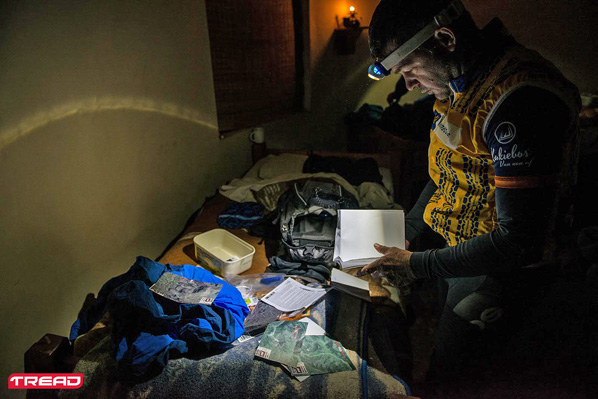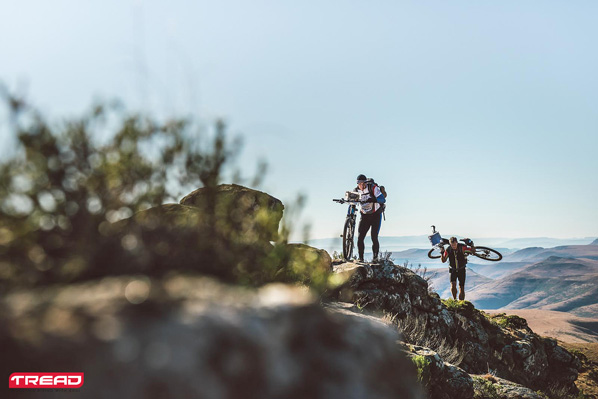You’ve probably heard about the Freedom Challenge, the annual non-stop race across South Africa. You’ve probably decided it’s not your thing. But you should probably read this summary of the 2015 edition of the event because it gives you some insight into what’s required to finish this race. And it makes you think quite hard about giving it a bash…
By Mike Ward
Photos: Hayden Brown/Pyga Industries

Within the diverse and growing tribe of mountain bikers there is a small clan known as the ‘blanket wearers’. They have taken up one of the greatest challenges in mountain biking: to ride 2300km across South Africa through some of the most beautiful and remote parts of KwaZulu-Natal, the Eastern Cape and the Western Cape. The trail, known as the Freedom Trail, has riders in awe as it links together district roads, farm tracks, old wagon routes, cattle tracks and sometimes no track at all. A number of events take place along this magical thread across our country. The best known is the Race Across South Africa (also commonly known as the Freedom Challenge) that takes place in mid-winter (June/ July) each year.
Legend has it that way back in 2003, David Wadilove ran from Cape Town to Pietermaritzburg to compete in the Comrades Marathon. As he went he chatted to local inhabitants and pieced together a route that sought to stay off tar roads and traverse as many natural areas as possible. The following year David, along with his brother and a friend, ran the Comrades and then rode the trail from Pietermaritzburg to Wellington before paddling the Berg Canoe marathon. And so began one of the greatest mountain bike trails in South Africa. An increasing number of national and international participants discover its natural beauty and generous hospitality each year.

In numbers the challenge looks daunting: 2300km (if you don’t get too lost), 37 000m of ascent, 26 support stations and 83 maps with which to navigate. And you need to carry 8-10kgs of clothes, spares, water and food with you. But the numbers do little to give a sense of the scale of the undertaking. Without GPS you are forced to stop and look at your surroundings as you find your route with carefully prepared 1:50 000 maps, a narrative description of the route, a simple bike computer and a trusty compass. This can add hours to each day’s riding and ensures that long ridges like Lehana’s Pass or valleys like Baviaanskloof, Gamkaskloof and Stettynskloof are etched in your imagination long before you get to them and remain there for years after.
The vast majority of the route is rideable but there is usually a section each day that requires that you push the bike or put it on your back and carry it. These portages have a fearsome reputation and some, such as Lehana’s Pass over the Drakensberg, the Osseberg into Bavianskloof, Die Leer out of Die Hel and Stettynskloof in the Dutoitsberge are spoken about in hushed tones whenever blanket wearers get together.

So how does a mountain biker survive along the Freedom Trail? Very well actually as one of the greatest achievements of this trail is to bring together some of the most welcoming and generous hosts that it has ever been my good fortune to meet. There are 26 support stations and a number of intermediate stops spread across the country at 50-100km intervals. These vary from farm houses, to game lodges, to rural schools and communities, to hotels, to historic missions. What does not vary is the unbelievable commitment of the hosts who seem never to sleep as riders arrive at all hours needing food, a shower, warm beds and laundry washed and dried before early departures. As guests in these support stations it is obvious that we benefit from years of relationship-building by the race organisers and previous riders. And it is this chance to interact with such a diversity of people that makes the Freedom Challenge as much a cultural experience as it is a ride through such a diversity of ecosystems.
But this is also a race and while only a few people each year are racing to win, many of us set our own personal challenges – not just to finish but to finish in a time that gets us up early and enjoying our bikes all day long. The length of each day is entirely up to each individual rider. Essentially this is a one-stage stage race. From the time you start in Pietermaritzburg, the clock starts ticking and it does not stop until you finish at Diemersfontein wine estate in Wellington near Cape Town. This means that any time you spend sleeping or eating or sorting out bike maintenance issues, all add to your final finishing time. The current record holder, Martin Dreyer (7 times Dusi canoe marathon winner), finished in 10 days 16 hours and averaged 2-3 hours of sleep per day throughout this time. The 2015 race winner, Tim James, spent less than 80 hours in support stations over the 13 days 7 hours that it took him to win. Interestingly, Andrew Barnes (who came second by just 30 minutes) rode faster between support stations but then spent almost twice as long recovering and enjoying the hospitality at the support stations.
Somewhere between the racing snakes and the 26 day cut-off is where the vast majority of the riders set their personal challenge. For most this means sticking to the support stations from Pietermaritzburg to Rhodes Village (6 support stations) and then doubling up on some of the easier days through the Karoo. At present the average finishing time is 20 days. There will always be those who seek to maximise the time on the trail and the hospitality of the support stations (but there are several cutoffs along the route). And there are those who enjoy the challenge of early starts and late finishes as they push through two and occasionally three support stations in a day.

So what would an average day look like for somebody who sets out with a 17-day target? Firstly a target below 24 days is going to require a substantial amount of riding in the dark. With about 10 hours of light, navigation is always going to be a big consideration as it gets so much harder to orientate yourself in the dark. As you push for a time under 20 days there will be many days that start with 2-3 hours of riding before first light and often go 2-3 hours into the dark in the evening. Although temperatures may well be below -10C, the magnificent night skies visible from the dark remote parts of the trail more than compensate for the cold. Watching sunrise and then sunset as you pedal your way across the country day after day is a bit of an acquired taste, but it can soon become something that you seek out and savour.
Despite the joy of cycling, arriving at a support station provides another kind of joy. Here you collect a 2litre ice cream container that you packed weeks before; the race organisers and Aramex courier company deliver these to each of the support stations. Filled with snacks, bum cream, bike spares, maps for the next section of trail, notes of support from family, and other paraphernalia, these are opened and traded each evening. Also on offer at the support stations are delicious home-cooked meals, hot showers, warm beds, laundry facilities and great company. Squirt provides chainlube, bike wash and bum cream for free along the trail which helps to keep bike and body in working order.

Every rider will no doubt have different parts of the trail that have special significance. This year, the snow as many of the earlier batches went past Rhodes Village, gave the southern Drakensberg mountains a quiet purity that will be remembered by those riders lucky enough to be up there. The Karoo had had good rains prior to the race and it was looking greener than usual. Similarly the rivers in the Osseberg and the Baviaanskloof were flowing strong and clear and the aloes were in full flower through most of the Eastern Cape. As we rode up the Swartberg Pass and into Gamkaskloof (Die Hel) the sun rose onto a green but frozen landscape as the clear nights revealed more stars than we ever imagined existed.

Each rider – no matter if you win the Race Across South Africa or sneak in on day 26 – receives a Basotho blanket and a bottle of Diemersfontein wine. And so it is that 178 of the great mountain biking tribe are known as blanket wearers. This small group has ridden along and over most of the great mountain ranges across South Africa. They have formed great friendships along the trail and met amazing people. They have felt what John Muir so beautifully captured in a quote slipped into one of the ice-cream boxes by my wife: “Climb the mountains and get their good tidings. Nature’s peace will flow into you as sunshine flows into trees. The winds will blow their own freshness into you, and the storms their energy, while cares will drop away from you like the leaves of Autumn.”
For more information on the range of events that take place along the Freedom Trail see www.freedomchallenge.org.za
Mike Ward completed the Race to Rhodes in 2014 and the Race Across South Africa (RASA) in 2015. Mike finished in 17 days 12 hours.

By the numbers
| Freedom Challenge | Cape Epic | |
| Distance | 2 300km | 748km |
| Cumulative Ascent | 37 000m | 16 000m |
| Average number of days | 20 (cut off at 26 days) | 8 |
| Entry fee | R24 500 per rider | R28 000 per rider |
| Cost per day | R1 225 (based on average of 20 days) | R3 500 |
As with many of the MTB trails and race routes in South Africa access to private and community land is not guaranteed and requires ongoing relationship building and permissions. This is also true for the Freedom Trail. Although the original route was based on public roads and rights of way, this is no longer the case and as the route has evolved over the years it now traverses extensively across private farms and communal land. Therefore, the only way to access the route is by entering Freedom Challenge events or by prior arrangement with the Freedom Challenge race office.”
TREAD Magazine is sold throughout South Africa and can be found in: Spar, CNA, Exclusive Books, Discerning bike shops and on Zinio
*Originally published in TREAD Issue 37, Dec 2015 – All rights reserved



